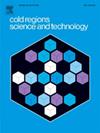一种防止水盐迁移的新方法:泡沫轻质土壤屏障层技术
IF 3.8
2区 工程技术
Q1 ENGINEERING, CIVIL
引用次数: 0
摘要
本研究提出了一种新型发泡轻质土(FLS)隔离层技术,以防止水和盐分迁移,解决季节性冰冻盐碱土地区的路基病害问题。为评估该方法的可行性和有效性,进行了一系列实验。首先,选择了十种不同比例的 FLS,并对相应的样品进行了无侧限抗压强度(UCS)和耐久性测试,以确定 FLS 隔离层的最佳比例。随后,在不同条件下进行了水盐迁移试验,包括不同的含盐量和隔离层位置。结果表明,阻隔层在防止盐渍土因盐分引起的变形方面具有良好的性能。在含盐量为 3% 的土壤中,有阻隔层的样本的垂直变形量仅为无阻隔层样本的 25.8%。对水盐迁移的进一步分析表明,阻挡层有效地阻止了盐分从样品底部向低温区域迁移,减轻了盐分在顶部积聚引起的膨胀。扫描电子显微镜(SEM)分析表明,FLS 的多孔结构可以储存盐分,并为盐膨胀提供足够的空间。本文章由计算机程序翻译,如有差异,请以英文原文为准。
A novel approach to water-salt migration prevention: foamed lightweight soil barrier layer technology
This study proposes a novel foamed lightweight soil (FLS) barrier layer technology to prevent water and salt migration and address subgrade diseases in seasonally frozen saline soil regions. A series of experiments were conducted to assess the feasibility and effectiveness of this approach. Initially, ten different ratios of FLS were selected, and the corresponding samples were tested for unconfined compressive strength (UCS) and durability characteristics to determine the optimal ratio for the FLS barrier layer. Subsequently, water-salt migration tests were performed under various conditions, including different salt contents and barrier layer positions. The results demonstrated the barrier layer's good performance in preventing salt-induced deformation of saline soil. In the soil with 3 % salt content, the vertical deformation of samples with a barrier layer was only 25.8 % of that observed in samples without the barrier. Further analysis of water-salt migration revealed that the barrier layer effectively prevented migration from the bottom of the sample toward the colder region, mitigating salt swelling caused by accumulation at the top. Scanning electron microscope (SEM) analysis revealed that the porous structure of the FLS can store salts and provide sufficient space for salt swelling.
求助全文
通过发布文献求助,成功后即可免费获取论文全文。
去求助
来源期刊

Cold Regions Science and Technology
工程技术-地球科学综合
CiteScore
7.40
自引率
12.20%
发文量
209
审稿时长
4.9 months
期刊介绍:
Cold Regions Science and Technology is an international journal dealing with the science and technical problems of cold environments in both the polar regions and more temperate locations. It includes fundamental aspects of cryospheric sciences which have applications for cold regions problems as well as engineering topics which relate to the cryosphere.
Emphasis is given to applied science with broad coverage of the physical and mechanical aspects of ice (including glaciers and sea ice), snow and snow avalanches, ice-water systems, ice-bonded soils and permafrost.
Relevant aspects of Earth science, materials science, offshore and river ice engineering are also of primary interest. These include icing of ships and structures as well as trafficability in cold environments. Technological advances for cold regions in research, development, and engineering practice are relevant to the journal. Theoretical papers must include a detailed discussion of the potential application of the theory to address cold regions problems. The journal serves a wide range of specialists, providing a medium for interdisciplinary communication and a convenient source of reference.
 求助内容:
求助内容: 应助结果提醒方式:
应助结果提醒方式:


